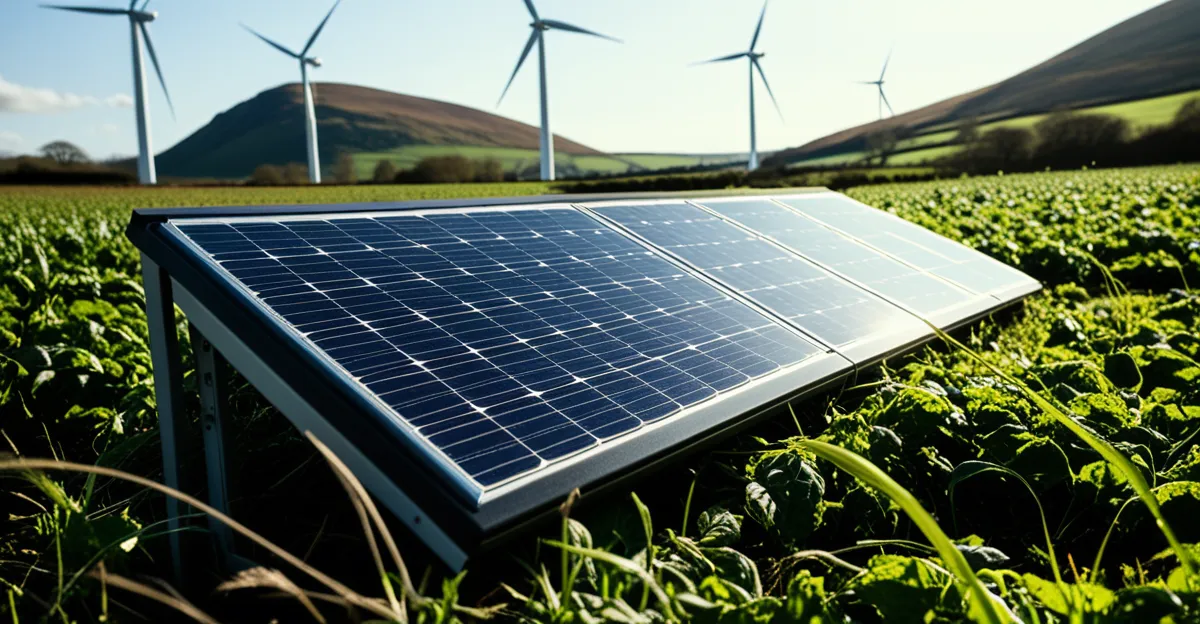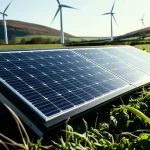Technological Innovations Driving Sustainable Energy in the UK
The UK sustainable energy technologies landscape is rapidly evolving, marked by significant advancements in renewable innovation. Central to this progress are key renewable energy technologies such as wind, solar, and hydroelectric power, which collectively contribute to the UK’s growing clean energy capacity.
Wind power remains a cornerstone of the UK’s green tech advancements. Offshore wind farms, benefiting from improved turbine design and higher capacity factors, now produce a substantial share of the nation’s electricity. Recent breakthroughs include larger, more efficient turbines capable of harnessing stronger winds at sea, which directly boosts energy output and reduces costs. Onshore wind technology is also seeing innovations, with smarter sensors and control systems enhancing operational efficiency and grid integration.
In the same genre : How Has UK Technology Transformed Everyday Life?
Solar energy technologies in the UK have evolved beyond traditional photovoltaic panels. Innovations such as bifacial panels, which capture sunlight on both sides, increase energy yield without additional space requirements. Additionally, developments in solar glass and integration with building materials allow broader deployment in urban areas, pushing renewable innovation beyond conventional installation sites.
Hydroelectric power, though less dominant, benefits from technological improvements in low-impact micro-hydropower systems. These solutions enable energy generation in smaller rivers and streams without large dam constructions, aligning well with environmental conservation goals.
This might interest you : What Future Technologies Are Starting to Shape the UK?
Beyond physical technologies, emerging digital solutions play an increasingly vital role in optimizing renewable energy systems. Artificial Intelligence (AI) and Internet of Things (IoT) devices enable real-time monitoring and predictive maintenance for wind turbines and solar arrays, reducing downtime and operational costs. Blockchain technology is beginning to enhance transparency and efficiency in energy trading and distribution, supporting decentralized grid models and empowering consumers through peer-to-peer energy exchanges.
In summary, the UK’s pursuit of sustainable energy is fueled by an interplay of physical renewable technologies and cutting-edge digital tools, together advancing the nation’s capability to produce cleaner, more efficient energy.
Governmental Strategies and Policy Integration
The UK energy policy plays a pivotal role in accelerating the adoption of sustainable energy technologies nationwide. By establishing clear targets aligned with climate goals, the government ensures renewable innovation is not merely encouraged but systematically integrated into national frameworks. For example, policies set ambitious carbon reduction objectives to be met by 2030 and 2050, driving the country’s transition away from fossil fuels toward cleaner alternatives.
Key government initiatives include funding schemes and support mechanisms aimed at both research and deployment of renewable projects. These initiatives provide financial incentives such as grants and tax reliefs to businesses and innovators working on green tech advancements. Legislative frameworks enforce stricter regulations on emissions and promote energy efficiency standards across sectors, ensuring comprehensive sustainability measures.
Moreover, the integration of these technology goals into the green energy regulation landscape facilitates coordinated action across multiple agencies and industries. This includes streamlining permits for offshore wind farms, encouraging smart grid deployment, and supporting digital tools like AI and IoT in energy management. Collectively, these policies create an ecosystem where technological advancements are rapidly translated into tangible environmental benefits.
By combining robust policy direction with financial and regulatory support, the UK government fosters an environment where renewable innovation thrives, directly contributing to national energy security and climate commitments.
Private Sector Contributions and Industry Case Studies
The UK private sector sustainability landscape is instrumental in accelerating the deployment of cutting-edge renewable energy solutions. Leading corporations are increasingly investing in corporate renewable projects that showcase scalable and commercially viable innovations. For instance, major energy companies have sponsored large-scale offshore wind farms, leveraging technological improvements to boost capacity and efficiency. These projects not only contribute significant clean energy generation but also create valuable industry benchmarks.
Collaboration is a defining characteristic of successful private sector efforts. Startups, established corporations, and public agencies frequently partner to combine expertise, funding, and regulatory support. This synergistic approach facilitates rapid development and deployment of novel technologies, such as AI-driven predictive maintenance and IoT-enabled energy management systems. By pooling resources, stakeholders overcome barriers that individual entities might face alone.
Highlighted industry case studies demonstrate practical outcomes of these partnerships. For example, a joint venture between a tech startup and an energy utility developed an AI-powered platform optimizing solar panel performance, leading to a measurable increase in energy yield. Another case involved integrating blockchain for transparent peer-to-peer energy trading within a community microgrid, fostering consumer engagement in sustainable energy.
These private sector examples illuminate how energy innovation case studies contribute vital insights into the scalability and impact of renewable technologies. They underscore the role of business agility and cross-sector collaboration in advancing the UK’s green energy transition, driving forward both technological progress and commercial success.
Implementation of Smart Grids and Energy Storage Solutions
Smart grids represent a transformative step in the UK’s sustainable energy landscape, integrating advanced digital technologies to enhance energy distribution and management. The deployment of UK smart grids involves sophisticated communication networks that enable two-way data exchange between energy providers and consumers. This real-time interaction facilitates improved load balancing, outage detection, and integration of decentralized renewable sources like wind and solar.
Energy storage technology plays a pivotal role in addressing the intermittent nature of renewables. Advances in battery storage, including lithium-ion and emerging solid-state batteries, provide efficient means to store excess electricity generated during peak production. This stored energy can then be dispatched during periods of low generation, ensuring grid stability and maximizing renewable energy utilization.
Grid modernisation efforts encompass both hardware upgrades and software innovations. Smart grid infrastructure supports predictive analytics powered by AI and IoT, which optimize energy flows and anticipate demand fluctuations. Furthermore, these systems enhance resilience against outages by enabling rapid response and decentralized management.
In practice, the integration of smart grids and energy storage technologies contributes significantly to the UK’s renewable innovation drive. By enabling more efficient and reliable energy systems, these advancements help to reduce reliance on fossil fuels while improving overall grid performance. The result is a smarter, cleaner, and more resilient energy ecosystem aligned with national sustainability goals.
Statistical Analysis and Impact Assessment
Recent UK renewable energy statistics reveal a significant upward trend in clean energy generation, with wind, solar, and hydroelectric power collectively supplying over 40% of the nation’s electricity as of 2023. This milestone underscores the effectiveness of sustained investments in UK sustainable energy technologies. Emission reduction figures align closely with these advances, showing a marked decrease in carbon output—approximately a 30% decline since 2010—demonstrating the tangible environmental benefits of renewable innovation.
Impact assessment highlights that wind power, particularly offshore installations, remains the largest contributor to renewable generation, accounting for roughly 25% of total electricity production. Solar energy, enhanced by innovations like bifacial panels, now contributes nearly 10%, while hydroelectric sources make up a smaller but important share, about 5%. These proportions indicate the diverse yet complementary roles of various renewable technologies within the UK energy portfolio.
Comparative analysis between renewable and traditional fossil fuel sources shows clear advantages: renewables exhibit lower lifecycle greenhouse gas emissions and reduced operational costs over time. However, intermittency challenges persist, which recent technological improvements in energy storage technology and UK smart grids are helping to mitigate by enhancing grid flexibility and stability.
Overall, this data-driven evaluation confirms that technological advancements and policy support in the UK are driving measurable progress toward a sustainable energy future. As adoption expands, continuous monitoring of these statistics will remain vital to guide strategic decisions and maintain momentum in reducing the carbon footprint nationwide.
Challenges, Opportunities, and Future Directions
The UK’s sustainable energy sector faces notable barriers to UK renewable adoption, including intermittency of renewable sources, grid integration complexities, and high initial investment costs. Intermittency, caused by variable wind and solar output, challenges consistent power supply. Overcoming this requires enhanced energy storage technology and smarter grid solutions, as previously discussed in relation to UK smart grids. Additionally, integrating diverse renewable systems into the existing grid infrastructure involves technical and regulatory hurdles that can slow deployment.
Despite these challenges, significant energy sector opportunities exist. Innovations in digital technologies such as AI and IoT offer powerful tools for predictive maintenance, demand response, and optimized resource allocation, further accelerating renewable innovation. Advances in hydrogen fuel and tidal energy also present promising avenues to diversify the UK’s clean energy mix. Financial incentives and evolving green energy regulation support increased private sector investment, creating a fertile environment for growth.
Looking ahead, the future green technology UK landscape is set to expand through a combination of technological breakthroughs and policy evolution. This includes scaling up offshore wind capacity with next-generation turbines and widespread adoption of decentralized energy systems empowered by blockchain. The UK aims to leverage these advancements to meet ambitious net-zero targets by 2050, underscoring robust plans to transform its energy portfolio sustainably and resiliently.








